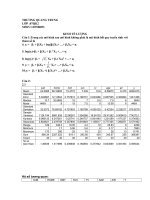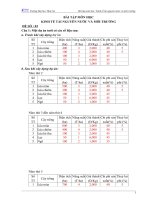bai tap môn học kinh tế quản lí đây các cậu ơi
Bạn đang xem bản rút gọn của tài liệu. Xem và tải ngay bản đầy đủ của tài liệu tại đây (18.71 KB, 2 trang )
1. The X-Corporation produces a good (called X) that is a normal good. Its
competitor, Y-Corp., makes a substitute good that it markets under the name “Y. ”
Good Y is an inferior good.
a. How will the demand for good X change if consumer incomes increase?
As income goes up, consumers typically buy more of these goods at any given
price. Conversely, when consumers suffer a decline in income, the demand for a
normal good will decrease (shift to the left).
b. How will the demand for good Y change if consumer incomes decrease?
c. How will the demand for good X change if the price of good Y decreases?
d. Is good Y a lower-quality product than good X? Explain.
It is important to point out that by calling such goods inferior, we do not imply that
they are of poor quality; we use this term simply to define products that consumers
purchase less of when their incomes rise and purchase more of when their incomes
fall.
2. Good X is produced in a competitive market using input A. Explain what would
happen to the supply of good X in each of the following situations:
a. The price of input A increases.
The supply curve reveals how much producers are willing to produce at alternative
prices. As production costs change, the willingness of producers to produce output
at a given price changes. In particular, as the price of an input rises, producers are
willing to produce less output at each given price. This decrease in supply is
depicted as a leftward shift in the supply curve.
b. An excise tax of $1 is imposed on good X.
An excise tax shifts the supply curve up by the amount of the tax, as in Figure 2–7.
Note that at any given price, producers are willing to sell less gasoline after the tax
than before. Thus, an excise tax has the effect of decreasing the supply of a good.
c. An ad valorem tax of 5 percent is imposed on good X.
Another form of tax often used by a government agency is an ad valorem tax. Ad
valorem literally means “according to the value.” An ad valorem tax is a
percentage tax; the sales tax is a well-known example. If the price of a good is $1
and a 10 percent ad valorem tax is attached to that good, the price after the tax is
$1.10. Because an ad valorem tax is a percentage tax, it will be higher for highpriced items.
d. A technological change reduces the cost of producing additional units of good X.
Technological changes can affect the position of the supply curve. Changes that
make it possible to produce a given output at a lower cost, , have the effect of
increasing supply.
3. Suppose the supply function for product X is given by 50 + 0.5Px 5Pz. a. How
much of product X is produced when Px $500 and Pz $30? b. How much of
product X is produced when Px $50 and Pz $30? c. Suppose Pz $30. Determine
the supply function and inverse supply function for good X. Graph the inverse
supply function.









